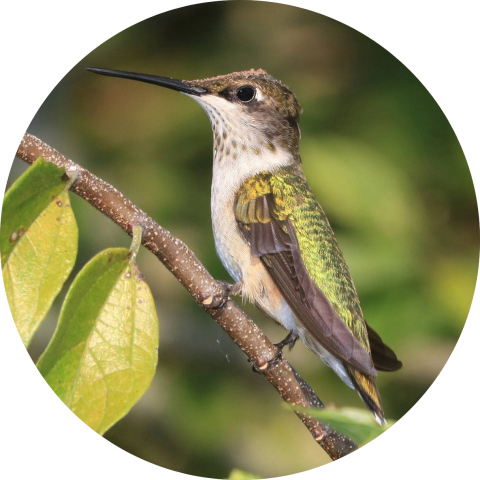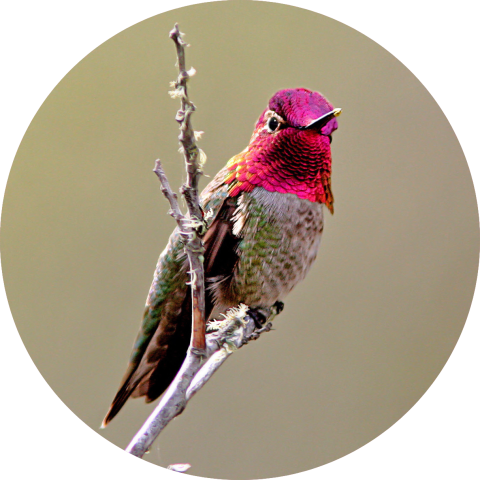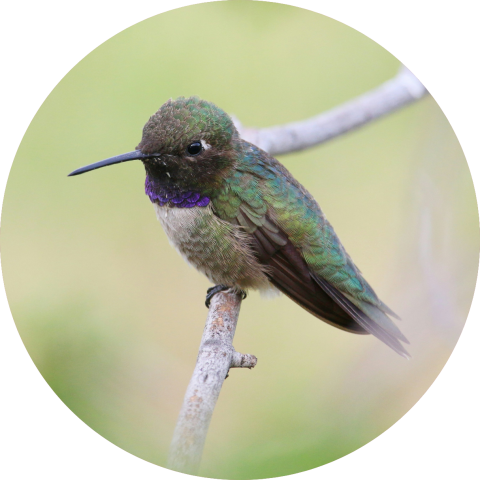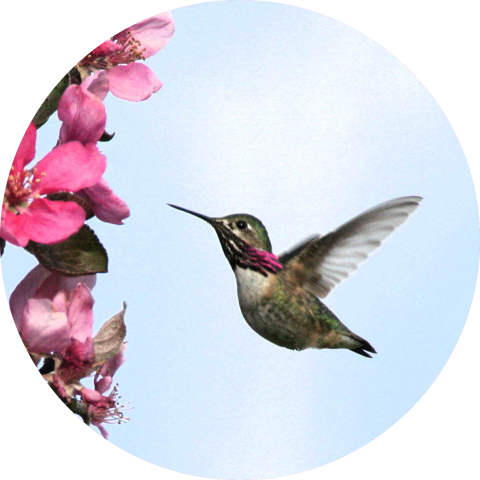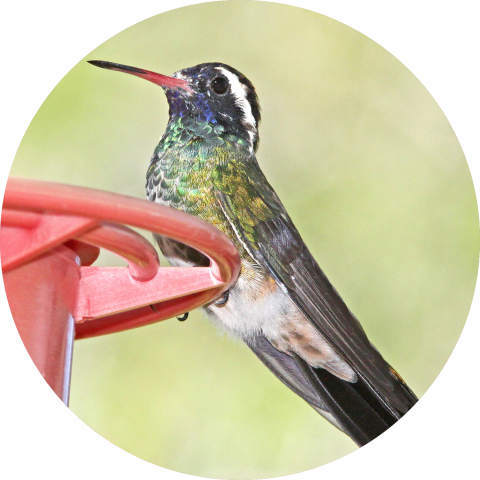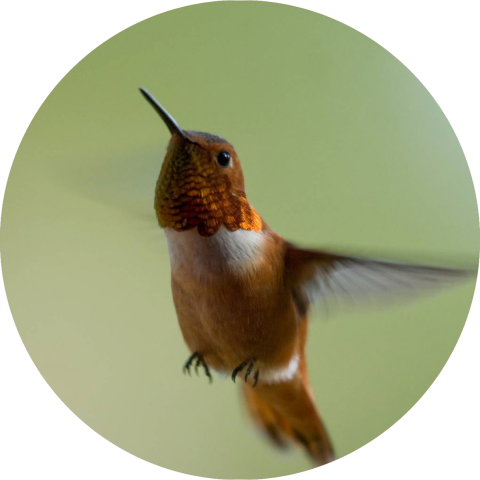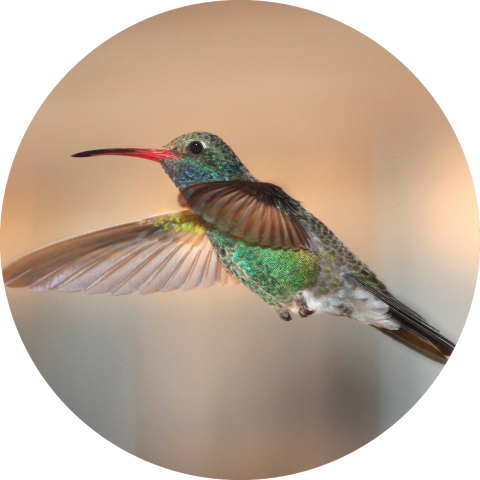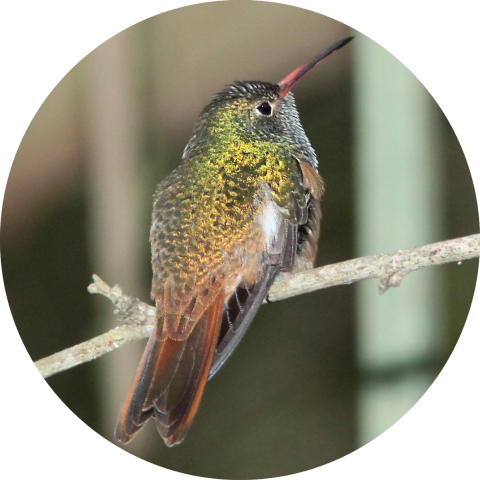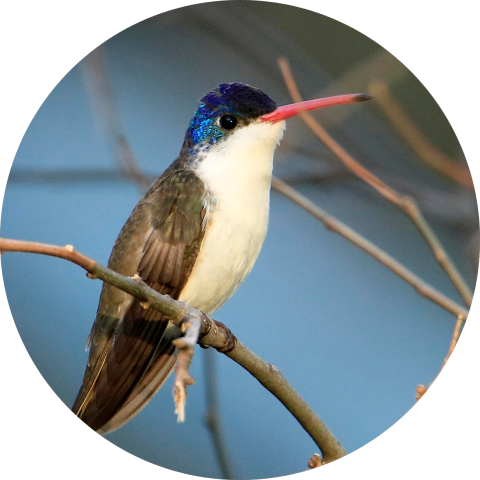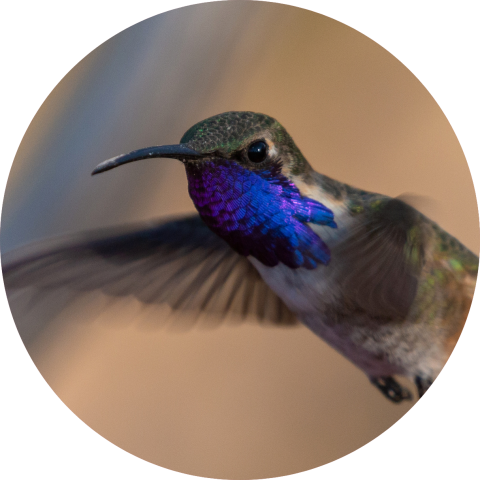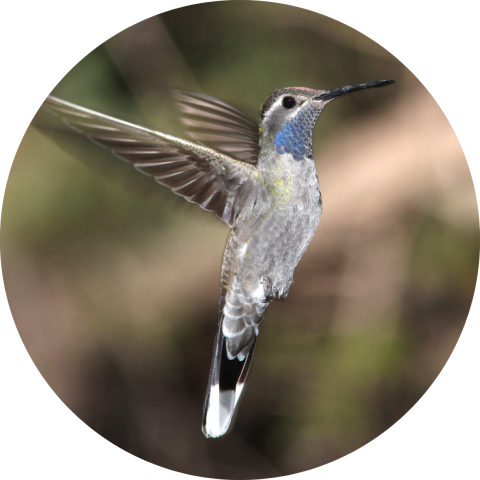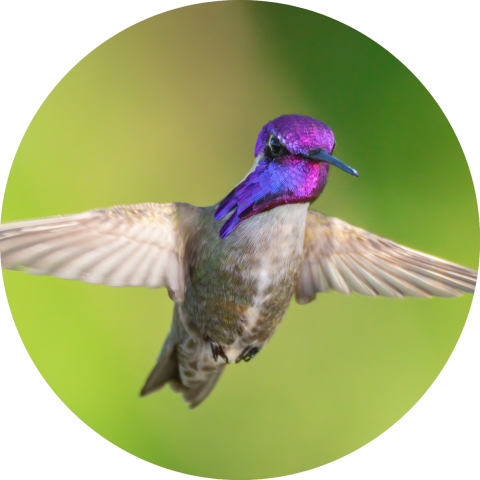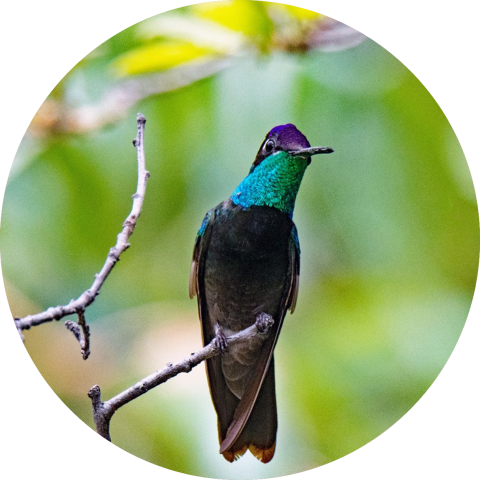Hummingbirds are tiny, vibrant marvels of nature, renowned for their dazzling colors and extraordinary agility. Despite being some of the smallest birds in the world, they have a big impact as pollinators, indicators of climate change climate change
Climate change includes both global warming driven by human-induced emissions of greenhouse gases and the resulting large-scale shifts in weather patterns. Though there have been previous periods of climatic change, since the mid-20th century humans have had an unprecedented impact on Earth's climate system and caused change on a global scale.
Learn more about climate change , and in balancing insect populations. Weighing less than a marshmallow, they fly at speeds of up to 30 miles per hour, constantly moving as they travel between plants. Hummingbirds have co-evolved with numerous plants to pollinate them as they drink from their nectar. While nectar is their primary food source, they also consume spiders, insects and tree sap, especially during the breeding season when protein is essential for their young. They live a very fast, busy life and do it mostly solo. To conserve energy, hummingbirds can enter a state of torpor, slowing their metabolism and lowering their body temperature when environmental conditions are challenging. For neotropical migratory bird species, those that travel between North America and the tropics depending on breeding and non-breeding seasons, it is especially important to gather enough food resources and conserve energy along the way.
When not eating, resting, or migrating, hummingbirds are often seen using their unique agility in a high-speed chase to fiercely defend their territory and protect their young during breeding and nesting seasons. Instead of flapping their wings in flight, these little acrobats can rotate 180 degrees in a figure-eight pattern up to 80 times per second, allowing them to fly backwards, hover in place, and quickly change direction with remarkable control. In both territorial defense and mating rituals, males can be seen diving and flashing a colorful gorget, a patch of iridescent feathers on their throats that shimmer spectacularly in sunlight. These incredible qualities of the hummingbird have earned them many nicknames, from flying jewels and sun gems to hummers and warriors.
All hummingbirds are found exclusively in the Western Hemisphere, from the southern tips of South America to as far north as Alaska. Out of the 366 hummingbird species gracing the Americas, the following species are the most commonly found in the United States:
Ruby-throated Hummingbird
Scientific name: Archilochus colubris
Habitat: Deciduous forests, woodlands, orchards, and gardens .
Location: Breeding Range: Eastern United States (from the Gulf of Mexico to southern Canada); Non-breeding Range: Central America (southern Mexico, Honduras, Costa Rica)
National Wildlife Refuges: Bombay Hook NWR (Delaware), Great Dismal Swamp NWR (Virginia), Patuxent Research Refuge (MD), Chincoteague NWR (VA), Okefenokee NWR (GA), Big Branch Marsh NWR (LA)
Diet: Nectar from flowers; Insects (e.g., mosquitoes, gnats, fruit flies, small bees) and spiders
Plants Pollinated: Trumpet creeper; coral honeysuckle; cardinal flower
Fun Facts: The male ruby-throated hummingbird has a ruby-red throat patch called a gorget, which gives the species its name. During migration, they can fly non-stop for up to 18-20 hours across the Gulf of Mexico. They migrate solo over the Gulf of Mexico, a journey of about 500 miles.
Anna's Hummingbird
Scientific name: Calypte anna
Habitat:Coastal sage scrub, gardens, and urban areas
Location:Western United States (primarily California, but also parts of Arizona, Nevada, and Oregon), year-round resident
National Wildlife Refuges:Don Edwards San Francisco Bay NWR (CA); San Diego NWR (CA); Sacramento NWR (CA); Tijuana Slough NWR (CA)
Diet:Nectar from flowers; Insects (e.g., midges, whiteflies)and spiders
Plants Pollinated:Eucalyptus, manzanita, fuchsia
Fun Facts: Oddly, female Anna's have a tiny red gorget—females of most species have none. Anna's hummingbird were named after Anna Massena, an Italian duchess from the 19th century. They are one of only three hummingbird species that live year-round in the United States and Canada, and have the northernmost range of any North American hummingbird. During breeding season, they are mainly found in California. They eat more insects than any other North American hummingbird. Unlike many other hummingbirds, Anna's hummingbird is known to sing during its courtship display.
Black-chinned Hummingbird
Scientific name: Archilochus alexandri
Habitat: Deserts, mountains, and urban areas
Location:Breeding Range: Western United States (from California to Texas, including Utah, Nevada, and Arizona); Non-breeding Range: Mexico
National Wildlife Refuges: Lower Rio Grande Valley NWR (TX); Balcones Canyonlands NWR (TX); Imperial NWR (AZ); Sevilleta NWR (NM); Bosque del Apache NWR (NM)
Diet: Nectar from flowers; Insects (e.g., small beetles, wasps, ants) and spiders
Plants Pollinated: Ocotillo, agave, red yucca
Fun Fact: Black-chinned hummingbirds are strictly migratory, arriving in the spring and leaving in the fall, spending most of the winter in Mexico. Males don't participate in building the nest, incubating the eggs, or raising the young, but they do display a dramatic courtship dance and territorial defense by diving up to 100 feet above the ground in a U-shaped pattern, creating a loud wing buzz. Males also have a distinctive black gorget with a violet iridescent band at the base.
Calliope Hummingbird
Scientific name: Selasphorus calliope
Status: Bird of Conservation Concern
Habitat:Mountain meadows, forest edges, and shrubby areas
Location: Western North America from British Columbia, Canada to California and southwestern Mexico. They migrate northwest through the Pacific lowlands, and southeast along the Rocky Mountains.
National Wildlife Refuges:Kootenai NWR (ID); Malheur NWR (OR); Benton Lake NWR (MT);Red Rock Lakes NWR (MT); Camas NWR (ID)
Diet:Nectar from cup-shaped flowers or isolated tubulars that larger hummingbirds don't usually seek out; small flying insects like ants, aphids, gnats and mosquitos; sap from sapwells created by sapsuckers, likely consuming both sap and insects stuck in it
Plants Pollinated:Indian paintbrush, penstemon, fireweed
Fun Fact: They are the smallest bird in the U.S. and the smallest long-distant migratory bird in the world!
Broad-tailed Hummingbird
Scientific name: Selasphorus platycercus
Status: Bird of Conservation Concern
Habitat:Mountain meadows, forest edges, and open woodlands
Location:Western United States (Colorado, Utah, Wyoming, New Mexico, Arizona); Non-breeding Range: southern Mexico and Guatemala Mexico
National Wildlife Refuges:Alamosa NWR (CO), Monte Vista NWR (CO); Arapaho NWR (CO), Bosque del Apache NWR (NM), Bear River Migratory Bird Refuge (UT)
Diet:Nectar from flowers; Insects (e.g., flies, wasps, small beetles)and spiders; sap as a nectar substitute
Plants Pollinated:Columbine, larkspur, Indian paintbrush
Fun Facts: During courtship, male broad-tailed hummingbirds perform acrobatic moves and make a high-pitched whistling sound. For the 2024 World Migratory Bird Day theme – Protect Birds, Protect Insects, our partners at the Environment for the Americas selected the broad-tailed hummingbird as a focal species since it is a great example of an insectivore that greatly relies on insects as a food resource for their survival.
Allen's Hummingbird
Scientific name: Selasphorus sasin
Status: Bird of Conservation Concern
Habitat:Coastal scrub, chaparral, and gardens
Location: They breed in a narrow strip of coastal habitat from southern Oregon to southern California, and their actual breeding areas vary by year. They then migrate to different areas depending on their subspecies. One of the most restricted ranges of any hummingbird in the U.S.
National Wildlife Refuges:Hopper Mountain NWR (CA); Don Edwards San Francisco Bay NWR (CA); Tijuana Slough NWR (CA); San Pablo Bay NWR (CA)
Diet:Nectar from flowers; Insects (e.g., gnats, aphids, small flies)and spiders
Plants Pollinated:Bush monkeyflower, sage, fuchsia
Fun facts:Allen's Hummingbirds have two subspecies, one migratory and one sedentary. The migratory subspecies migrates earlier than most other North American birds, and may arrive on their breeding grounds as early as January after leaving their non-breeding grounds as early as December. Adult males make a buzzing sound with their outer flight feathers, similar to a bumblebee, when they fly in front of a female or other bird in their territory.
White-eared Hummingbird
Scientific name: Basilinna leucotis
Habitat: Montane forest, pine-oak woods. In Mexico and Central America found mostly in clearing and edges of coniferous forest in higher mountains, as well as pine-oak woods at middle elevations. In the U.S., has been seen most often coming to feeders in mountain canyons, in areas dominated by oak, pine, or Douglas-fir.
Location: Breed in southeastern Arizona, southwestern New Mexico, parts of western Texas; migrate to southern Mexico to southern Nicaragua during non-breeding months. Records show they have been observed as a vagrant all the way eastward to Mississippi and Michigan. Resident (non-migratory) populations exist in central Sonora (a state located in northwest Mexico) south to southern Central America.
Diet: Nectar from flowers, small insects (e.g., flies, beetles)and spiders
Plants Pollinated: Columbine, penstemon, desert willow
Fun Fact: They are one of the rarer hummingbird species to spot in the States. Where the species is common in Mexico, males gather in groups and perch in trees about 60-100 feet apart, singing short songs to attract females. Spanish common name – translated: sapphire white ear
Rufous Hummingbird
Scientific name: Selasphorus rufus
Status: Bird of Conservation Concern
Habitat:Forest edges, clearings, and mountain meadows
Location: Northwestern U.S. and Canadian forests down to Mexican highlands and the U.S. Gulf Coast. Breeds as far north as southeastern Alaska – the northernmost breeding range of any hummingbird in the world!
National Wildlife Refuges:William L. Finley NWR (OR), Conboy Lake NWR (WA), Malheur NWR (OR), Kootenai NWR (ID), Kodiak NWR (AK), Ridgefield NWR (WA)
Diet:Nectar from flowers, small insects (e.g., mosquitoes, aphids, beetles)and spiders
Plants Pollinated:Red columbine, wild currant, salmonberry
Fun Fact: Longest migration of any bird (measured in body lengths), at about 4,000 miles one-way from Alaska or Canada to Mexico and back again! This is equivalent to 78,470,000 body lengths, much longer than the 13-inch-long Arctic tern's 51,430,000 body length.
Broad-billed Hummingbird
Scientific name: Cynanthus latirostris
Habitat:Riparian woodlands, desert scrub, canyons, foothills, and streambeds.
Location: Primarily found in northwestern Mexico, but may also range into southern Arizona, southwest New Mexico, and west Texas in the spring and summer. Southern Arizona, southwestern New Mexico, western Texas; Migrates south to Mexico.
National Wildlife Refuges:Buenos Aires NWR (AZ), San Bernardino NWR (AZ)
Diet:Nectar from flowers, small insects (e.g., ants, beetles)and spiders
Plants Pollinated:Hummingbird trumpet, ocotillo, desert willow
Fun facts: Broad-billed hummingbirds have emerald bodies, vivid red bills with black tips, and wingspans of about 5 inches. Adult males also have vibrant blue throats, white undertail coverts, and black forked tails, while adult females have grayish throats and undersides, and pale outer tips on their tails. A distinguishing feature of females is the thin white spot behind their eyes. Broad-billed hummingbirds are one of the few hummingbird species to breed in the U.S. and northern Mexico; Like some other bird species, they are drawn to the sounds of diurnal owls, such as the ferruginous and Northern pygmy-owls, and will dive at the owl's head or perch nearby.
Buff-bellied Hummingbird
Scientific name: Amazilia yucatanensis
Habitat:Coastal woodlands, thickets, and gardens
Location: Along the gulf coast, especially the Lower Rio Grande Valley of Texas. Not too many Northern Hemisphere birds move north after the breeding season, but the buff-bellied hummingbird regularly disperses northeast into Louisiana from its breeding areas in southernmost Texas. May also migrate south to Mexico and Central America
National Wildlife Refuges:Santa Ana NWR (TX), Laguna Atascosa NWR (TX), Lower Rio Grande Valley NWR (TX)
Diet:Nectar from flowers, small insects (e.g., flies, beetles, ants)and spiders
Plants Pollinated:Turk's cap, coral bean, trumpet creeper
Fun Fact: The oldest recorded Buff-bellied Hummingbird was a male, and at least 11 years, 2 months old when he was recaptured and rereleased during banding operations in Texas.
Violet-crowned Hummingbird
Scientific name: Amazilia violiceps
Habitat:Arid scrub, canyons, and riparian riparian
Definition of riparian habitat or riparian areas.
Learn more about riparian woodlands
Location:Southern Arizona, southwestern New Mexico, parts of western Texas;Non-breeding Range: Mexico
National Wildlife Refuges:Buenos Aires NWR (AZ),San Bernardino NWR (AZ),Leslie Canyon NWR (AZ), Santa Ana NWR (TX)
Diet:Nectar from flowers, small insects (e.g., flies, beetles)and spiders
Plants Pollinated:Desert willow, Mexican bird of paradise, coral bean
Fun Fact: Easily recognized by its white belly and violet crown, they are the only hummingbird in the U.S. without a colorful throat patch, or gorget. They are also one of the largest hummingbird species in the U.S. at about 4 inches long. Violet-crowned hummingbirds are more frequently found in riparian areas compared to other hummingbird species.
Lucifer Hummingbird
Scientific name: Calothorax lucifer
Status: Bird of Conservation Concern
Habitat: Desert scrub, canyons, and arid slopes
Location: Desert regions of southwestern Texas, southern Arizona; They live in the U.S. from around March to September at elevations of 3,500–5,500 feet before migrating south to Mexico.
National Wildlife Refuges: Big Bend National Park (TX), Buenos Aires NWR (AZ)
Diet: Nectar from flowers, small insects (e.g., flies, beetles) and spiders;
Plants Pollinated: Agave, ocotillo, desert willow; have been observed picking up pollen and nectar from under agaves, which are adapted to be pollinated by bats.
Fun Fact: Males perform mating displays at female nests during nest-building and egg-laying, unlike other hummingbirds that perform displays away from nesting sites. The name "Lucifer" comes from the Latin word for "light-bearing" and may refer to the hummingbird's iridescent purple gorget.
Blue-throated Hummingbird
Scientific name: Lampornis clemenciae
Habitat:Montane forests, canyons, and riparian woodlands
Location:High elevations of southern Arizona, New Mexico, and the Chisos Mountains of Texas. Migrates south to Mexico for their non-breeding season.
Diet:Nectar from flowers, small insects and spiders
Plants Pollinated:Trumpet creeper, beardtongue, agave, penstemon
Fun Fact: Blue-throated hummingbirds are the largest hummingbird species that nests in the United States, about 3 times heavier than the ruby-throated hummingbird! They can be bold and aggressive in dominating other hummingbirds, capable of beating their wings about half as fast as smaller hummingbird species. Also unusual among other hummingbird species, both male and female blue-throated hummingbirds look similar and have complex songs sometimes sung in a duet and perform a series of short flights during courtship. The male has a striking cobalt blue gorget that's not easily seen as it's usually only visible at certain angles. when light its it or as it flies swiftly past shadows. They are also commonly referred to as the blue-throated "mountain-gem"
Costa's Hummingbird
Scientific name: Calypte costae
Status: Bird of Conservation Concern
Habitat: Sonoran and Mojave deserts, arid scrublands, and coastal sage scrub
Location: Southeastern California and of California and Arizona south to the North half of Mexico's west coast. Non-breeding range in northwestern Mexico (Baja California, Sonora)
National Wildlife Refuges: Sonny Bono Salton Sea NWR (CA), Imperial NWR (AZ), Cibola NWR (AZ/CA)
Diet: Nectar from flowers, small flying insects (e.g., gnats, aphids, beetles) and spiders
Plants Pollinated: Red penstemon, chuparosa, desert lavender, ocotillo
Fun Fact: Reaches its maximum size at 3.5 inches, making it one of the smallest U.S. breeding birds. Found in hot, dry habitats like the Sonoran and Mojave deserts, the species is an important pollinator of desert plants and cacti, especially red penstemon. They can survive in extreme desert conditions with temperatures exceeding 110°F.
Rivoli's Hummingbird
Scientific name: Eugenes fulgens
Habitat: Mountainous pine-oak forests, shady canyons, arroyos, riparian woodlands, and open hillsides.
Location: Year-round residents in north-central Mexico to northern Nicaragua, but migrate north in early spring to breed in forested mountains in Arizona and New Mexico. They may also nest in southeastern Arizona, southwestern New Mexico, and the Mexican states of Chihuahua and Sonora, but do not stay there in non-breeding months. Summer records exist in the Chisos Mountains of Texas, but breeding has not been confirmed there.
Diet: Nectar from flowers; small insects (e.g., flies, beetles) and spiders. They use their long bills to sip nectar from widely spaced patches of flowers, traveling along a steady route called "traplining"
Plants Pollinated: Mistletoe, trumpet creeper, agave (Agave spp.), penstemon
Fun facts: Rivoli's hummingbird were formerly known as the magnificent hummingbird from the 1980s until 2017. They are the second largest hummingbird species found in the U.S. at about five inches long, that's roughly the size of a sparrow and about two and a half times the size of a ruby-throated hummingbird!
Vagrant Hummingbird Species
The following hummingbird species also occasionally visit the United States from Mexico or nearby Central America:
- Berylline hummingbird (Amazilia beryllina): Rare visitors to the mountains of southeastern Arizona and Texas.
- Mexican violetear (Colibri thalassinus): Occasional visitor to Texas and Colorado.
- Bumblebee hummingbird (Atthis heloisa): Rare sightings in Arizona near the Mexico border.
Xantus's hummingbird (Basilinna xantusii): Occasionally seen in southern California.
Cinnamon hummingbird (Amazilia rutila): Sometimes migrates to Texas near the Mexico border.
- Green-breasted mango (Anthracothorax prevostii): Occasionally seen in south Texas along the Gulf Coast.
- Plain-capped starthroat (Heliomaster constantii): Sightings primarily in southeastern Arizona and New Mexico.
- Bahama woodstar (Calliphlox evelynae): Rarely seen in Florida, particularly in the southern part of the state.
- Green violet-ear (Colibri thalassinus): Occasionally sighted in eastern and southeastern parts of Texas.
- Long-billed starthroat (Heliomaster longirostris): Rare visitor to southern Arizona near the Mexican border.
- Amethyst-throated hummingbird (Lampornis amethystinus): Rare visitor to Arizona and New Mexico.
These vagrant species typically inhabit regions close to the United States in Mexico, Central America, or the Caribbean. They occasionally stray northward into the United States, usually due to changes in weather patterns, availability of food, or other environmental factors. Birders and wildlife enthusiasts often consider sightings of these vagrant species significant and exciting events.
Threats to Hummingbirds
Out of the species listed above, 6 are currently listed as a Birds of Conservation Concern: Costa's hummingbird, Calliope hummingbird, Rufous hummingbird, Allen's hummingbird, broad-tailed hummingbird, and lucifer hummingbird. This means they are included in a list of bird species for highest conservation priority based on several factors, including population abundance and trends, threats on breeding and nonbreeding grounds, and size of their range. For more information about the list see Bird of Conservation Concern. Although none of the species mentioned are currently listed as endangered or threatened under the Endangered Species Act, most hummingbird species face the same or similar threats as other migratory birds, including:
Climate Change
Climate change poses significant threats to hummingbirds. If climate changes faster than species can adapt, species may not be able to find the necessary habitat or food resources they rely on. Such changes can affect migration routes and timing, causing hummingbirds to end up in unfamiliar locations where they may struggle to find what they need or be vulnerable to other threats like extreme weather and predators.
Habitat Loss & Fragmentation
Deforestation and urban development are among the leading threats to birds. Over 80% of hummingbird species require forested areas and native vegetation found in grasslands or meadows, which are increasingly being destroyed or altered by human activities. The loss of these habitats can directly impact their ability to breed, shelter, feed, and nest. Even minor habitat changes can have significant impacts on these birds, as they rely on specific environmental conditions and food sources throughout their life cycle.
Invasive Species
Hummingbirds have many natural predators, including other birds, insects, and reptiles. However, it is invasive plants and animal species that pose the most threat to their population. Introduced or over abundant predator species can disrupt the delicate balance of ecosystems, often outcompeting native species and reducing the availability habitat and food resources like nectar plants and insects that birds depend on.
Flight Risks
Naturally, migration is a risky journey! We can help hummingbirds travel safely by reducing unnatural threats to birds at our homes and businesses like lights at night and glass structures. Light pollution can impact all species in a variety of ways, but especially impacts birds and insects when they are migrating at night. They can become disoriented and exhausted by the lights when they would otherwise use the starry night sky to navigate. This can also lead birds to collide with glass and other human structures that they can't see the same way we do. Both impacts by lights and collisions usually end up fatal or lead to birds becoming more vulnerable to other threats like predators or injury.
Insect Decline
While we mostly think of hummingbirds as nectar feeders and important pollinators of many species of flowers, they also depend on insects like most other bird species. In fact, as much as 20% of their diet is insects they capture in the air or find among the plants in our gardens, forests, and grasslands. Insects are also a critical source of food for their chicks. Studies are showing alarming declines in terrestrial insect populations, which may threaten these species survival.
How You Can Help
Creating Hummingbird-friendly Environments
- More Trees, More Leaves: Hummingbirds prefer to nest near a ready supply of nectar and other food like insects, so you can encourage them to live in or near your home or business by maintaining some shrubbery and deciduous trees in which they can seek protective cover. As seasons change, it can also help to leave any leaf litter on the ground as it becomes important habitat for many of the insects and spiders they also eat.
- Native Flowers: Incorporate native nectar plants in your garden to provide a reliable food source for hummingbirds. Plants such as columbine, trumpet vine, and bee balm are excellent choices.
- Fresh Water: Set up a shallow water source for them to bath and hydrate. Keep it clean and away from predators like domestic cats and high traffic areas where birds can become more vulnerable.
- Protect Against Predators: Keep cats indoors and create bird-friendly spaces that minimize the risk of predation.
- Pest Management Best Practices: Integrated Pest Management (IPM) is a holistic decision-making process that balances pest control with environmental stewardship, protecting hummingbirds and other wildlife. By combining knowledge of pest biology, environmental conditions, and site-specific management goals, IPM can reduce pesticide use, minimize risks, save time and money, and promote sustainable, healthy ecosystems.
- Reduce Light Pollution: Turn off or dim lights at night to prevent disorienting and exhausting migrating birds.
- Bird-safe Glass: Collisions with glass and other human made structures are a leading cause of death for birds, and hummingbirds may be especially vulnerable. To protect small birds like hummingbirds from window collisions, it is necessary to either use methods that make the entire window visible or to apply exterior patterns to the outside of the glass spaced no more than 2 x 2 inches apart. This can help smaller birds like hummingbirds see the glass as a threat to avoid. Check out our Bird Collision Reduction Toolkits to learn more!
Supporting Conservation Efforts
- Participate in Citizen Science Projects: Help track hummingbird populations by taking pictures of them or documenting when you see them with citizen science projects in your area to contribute to conservation research.
- Support Habitat Protection Initiatives: Get involved with efforts to restore or preserve hummingbird habitats.
- Advocate for Climate Action: Support practices that address climate change and protect natural habitats.
Even seemingly small actions can go a long way for these tiny wonders. Together, we can make a big impact.
Center for Pollinator Conservation
Neotropical Migratory Bird Conservation
2024 World Migratory Bird Day: "Protect Insects, Protect Birds"

